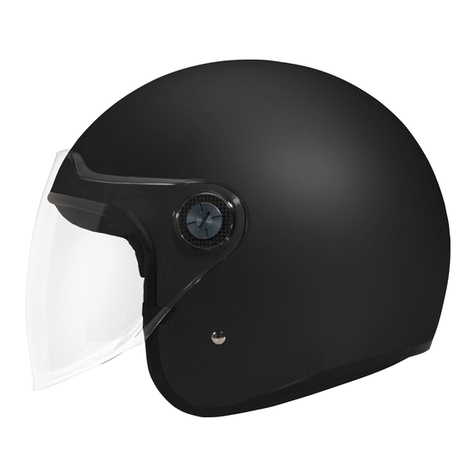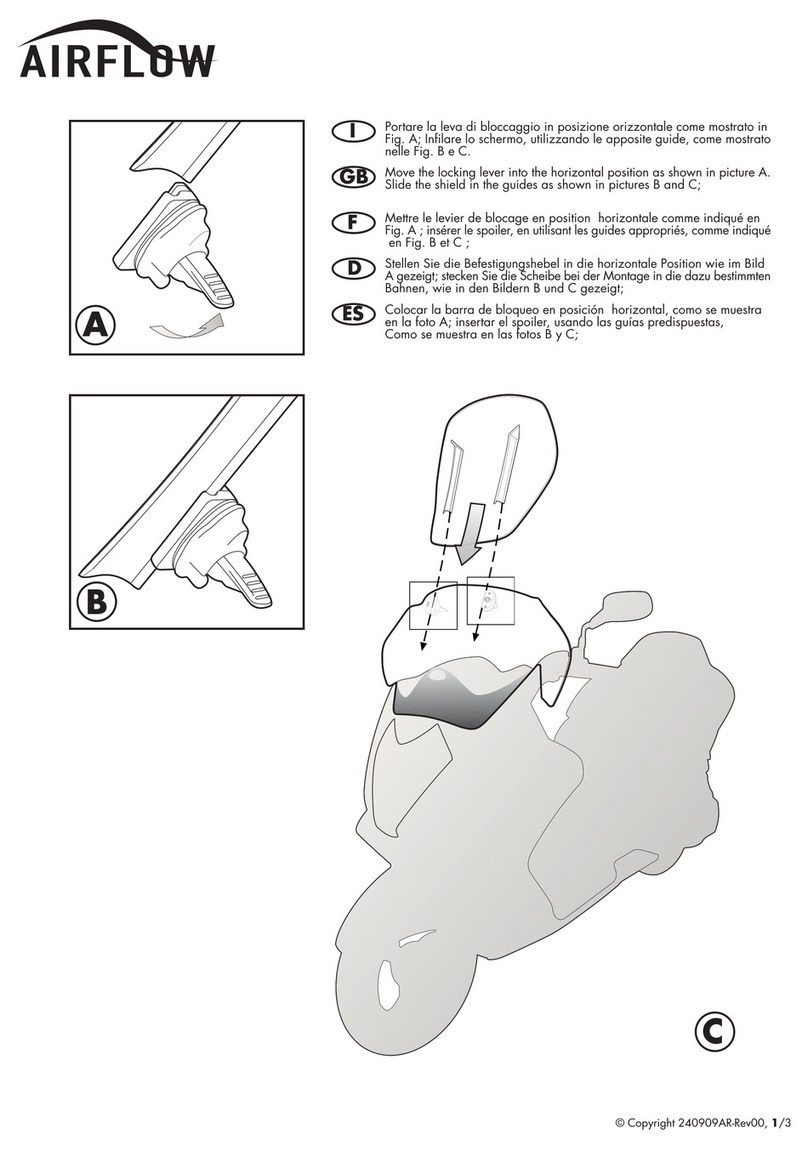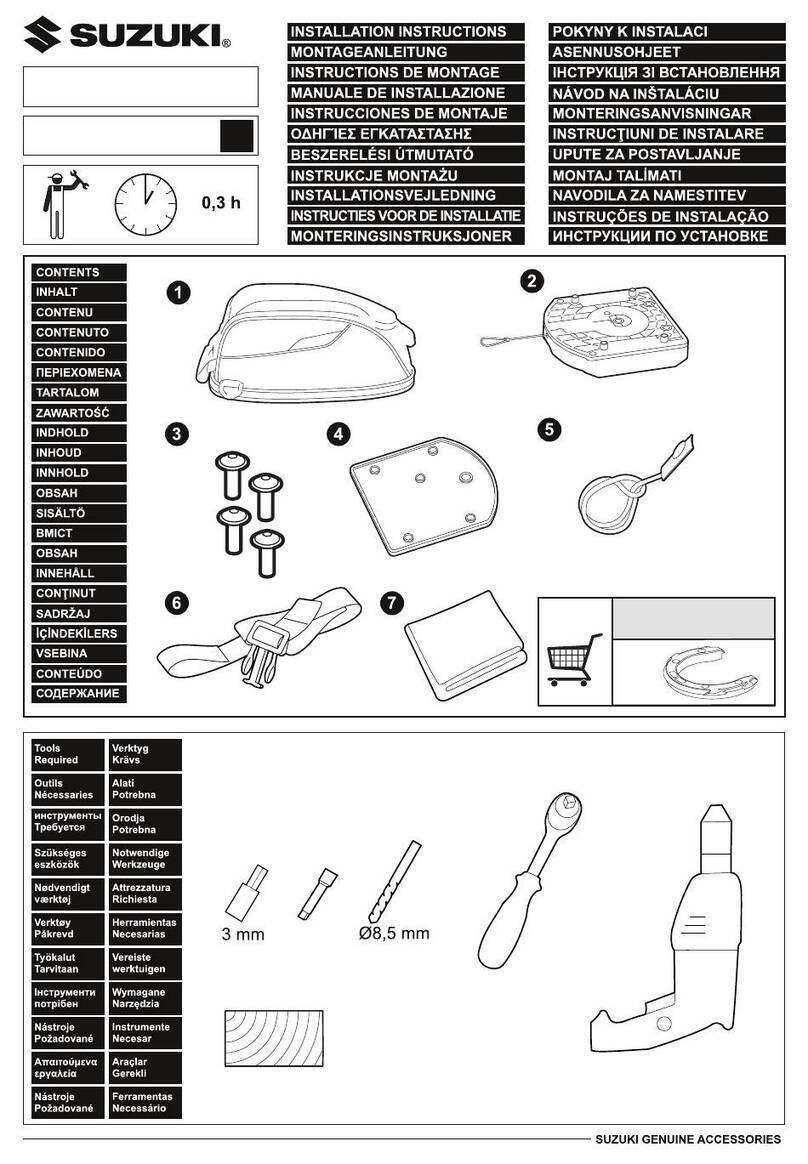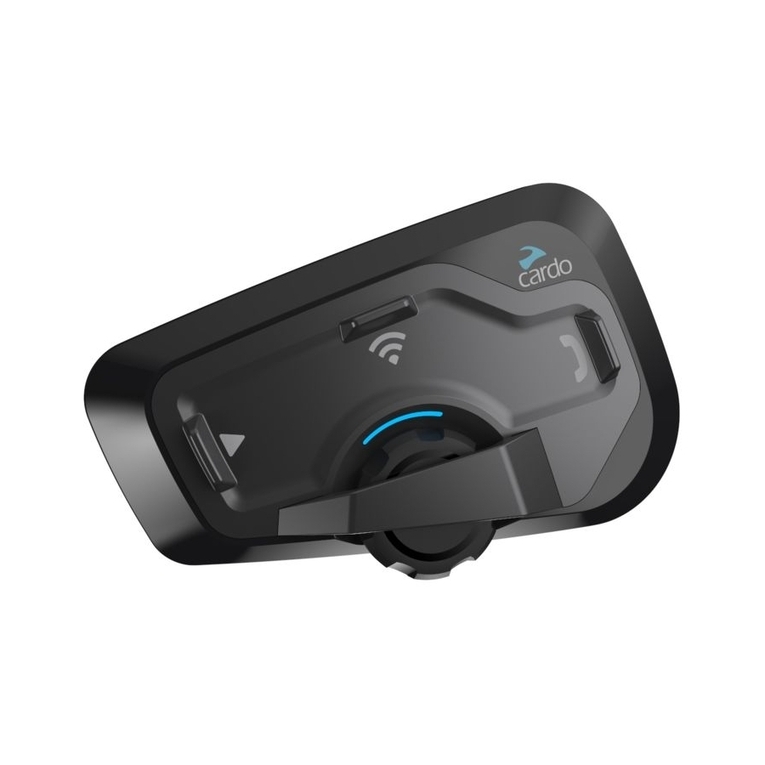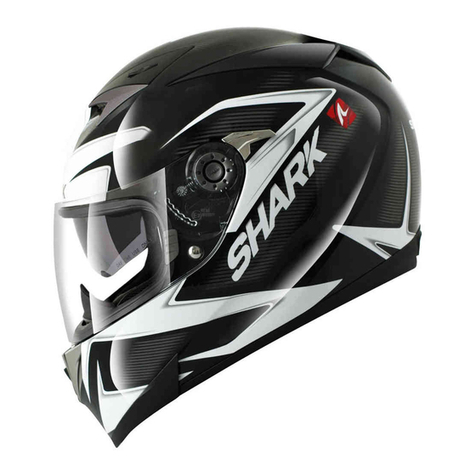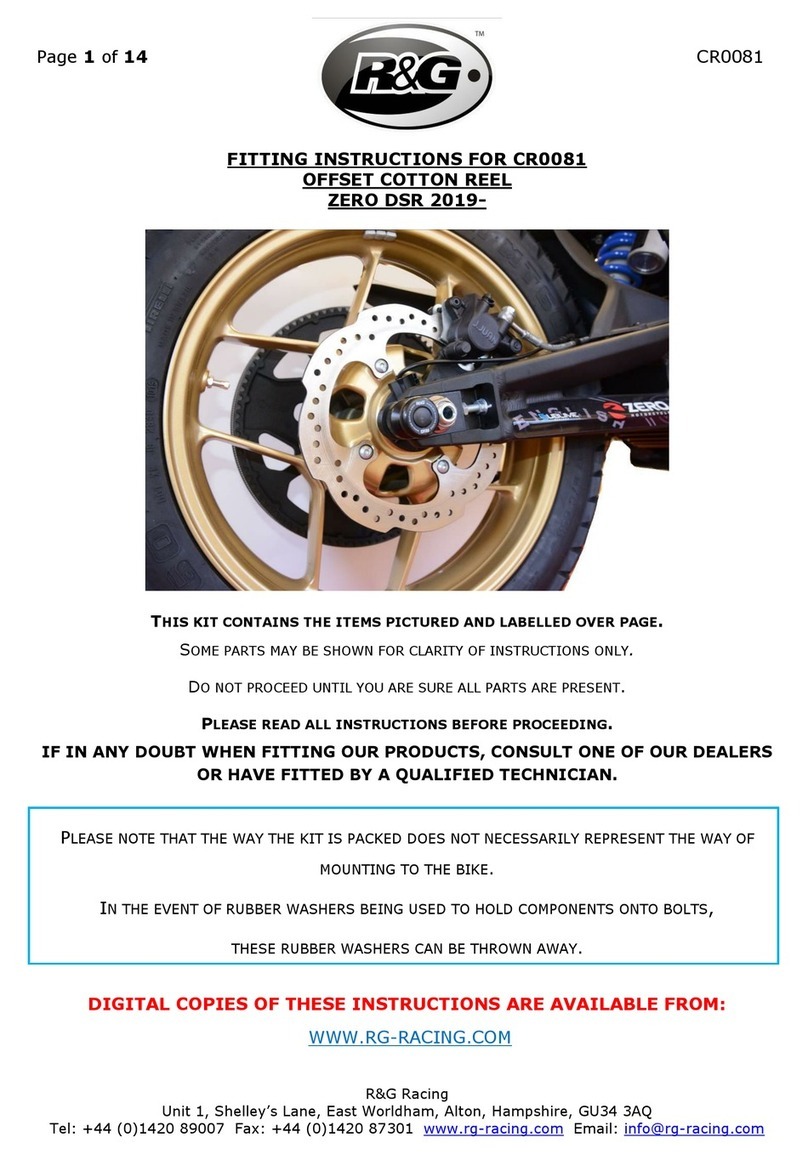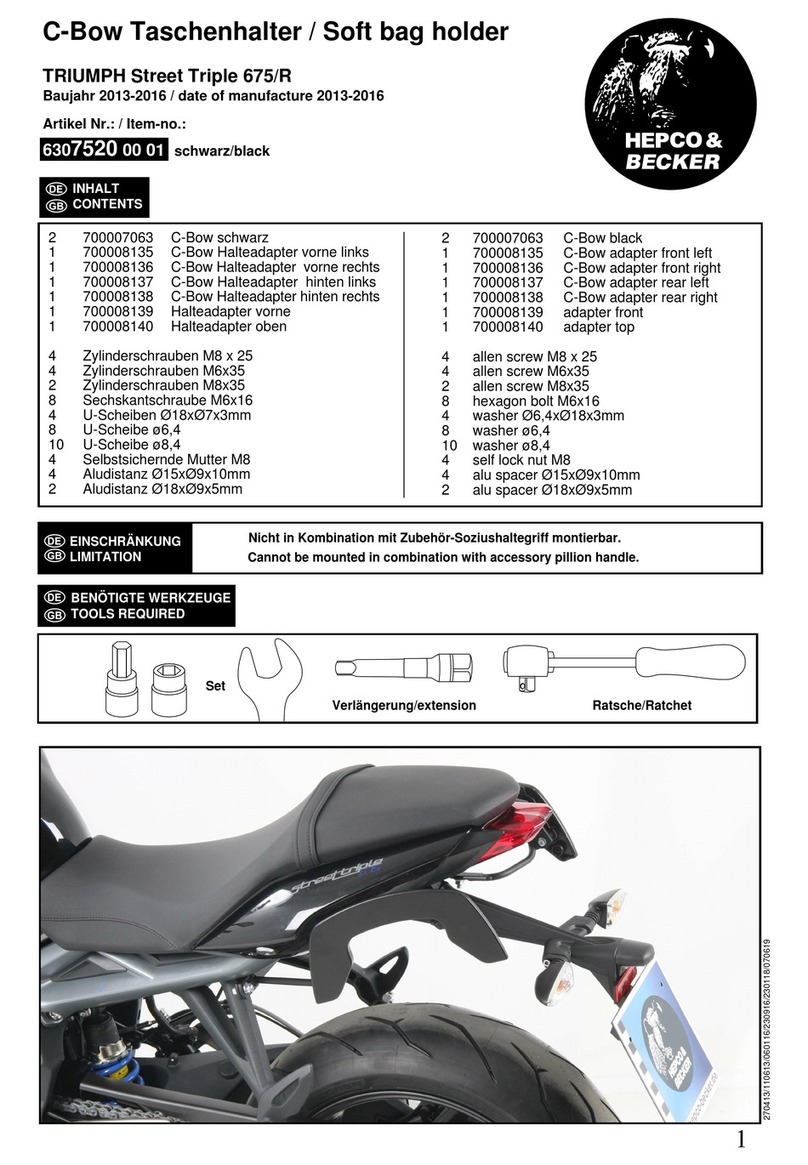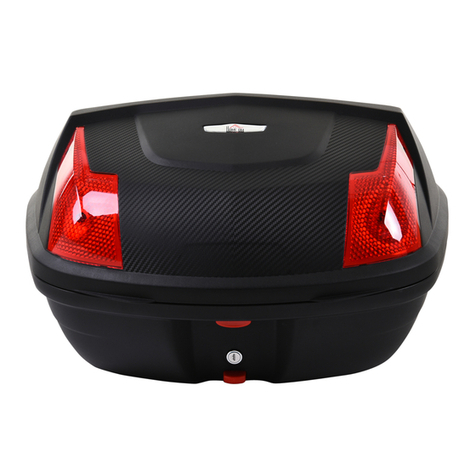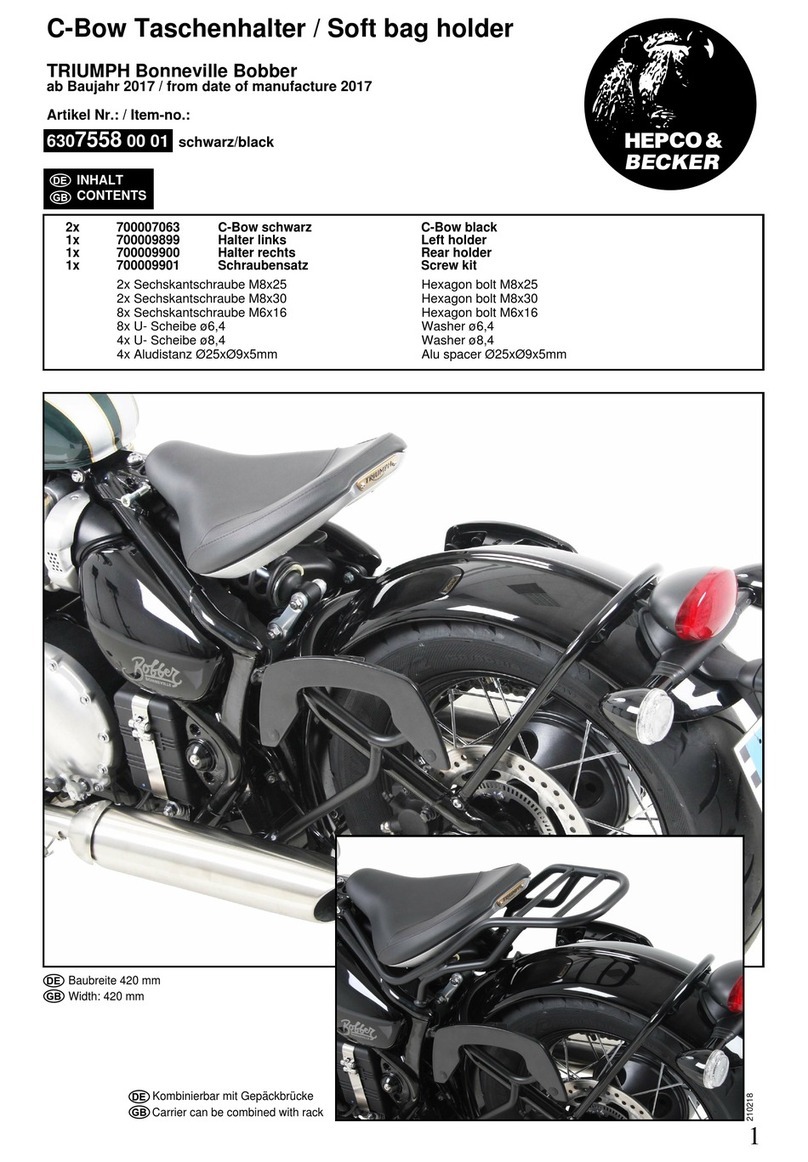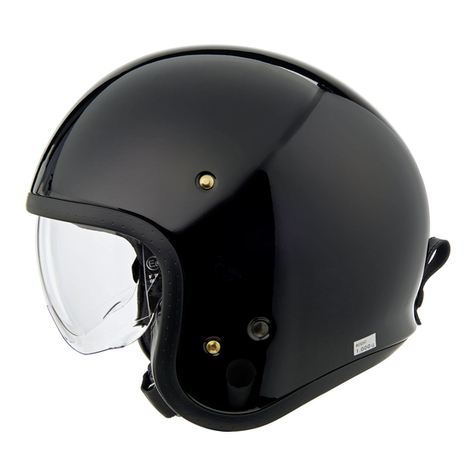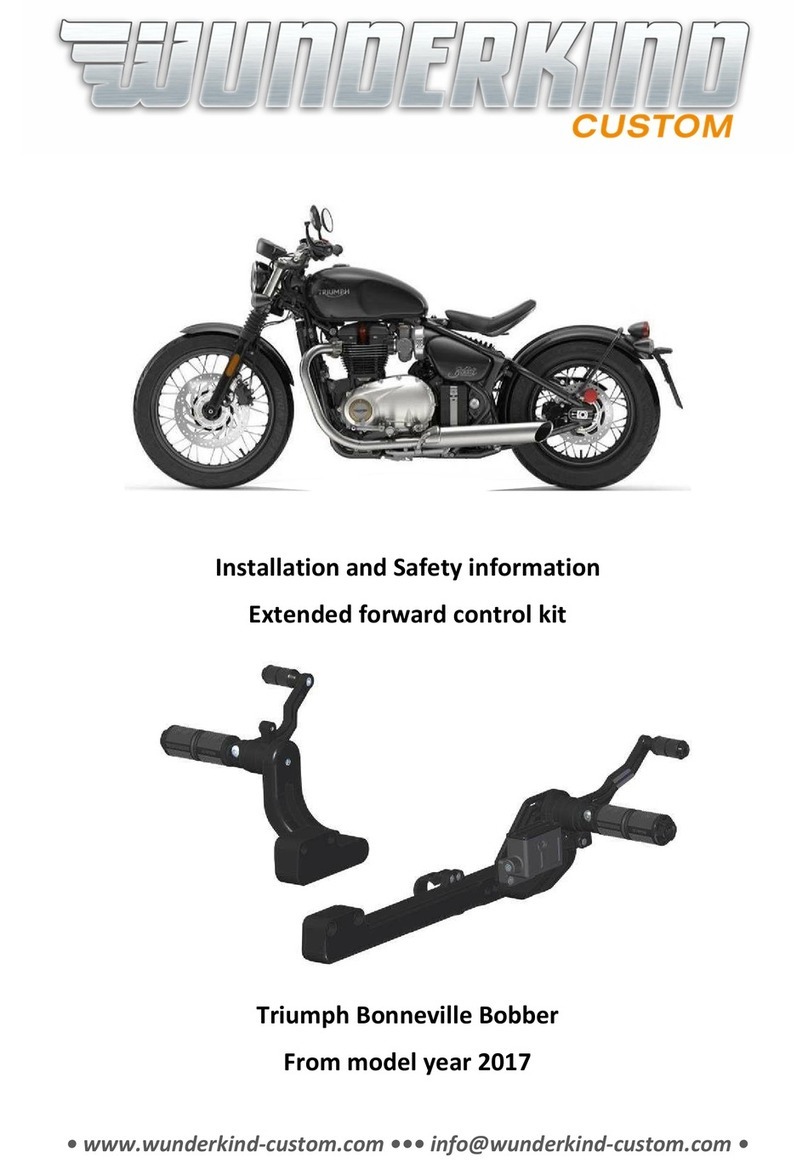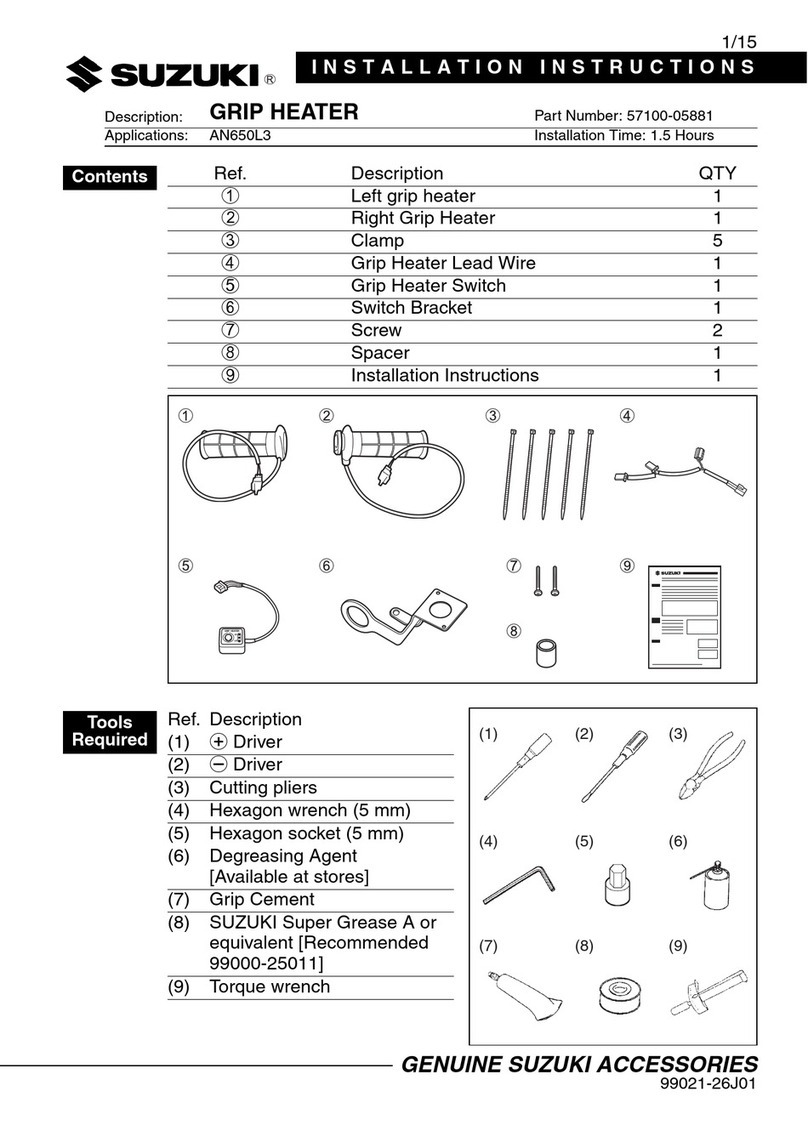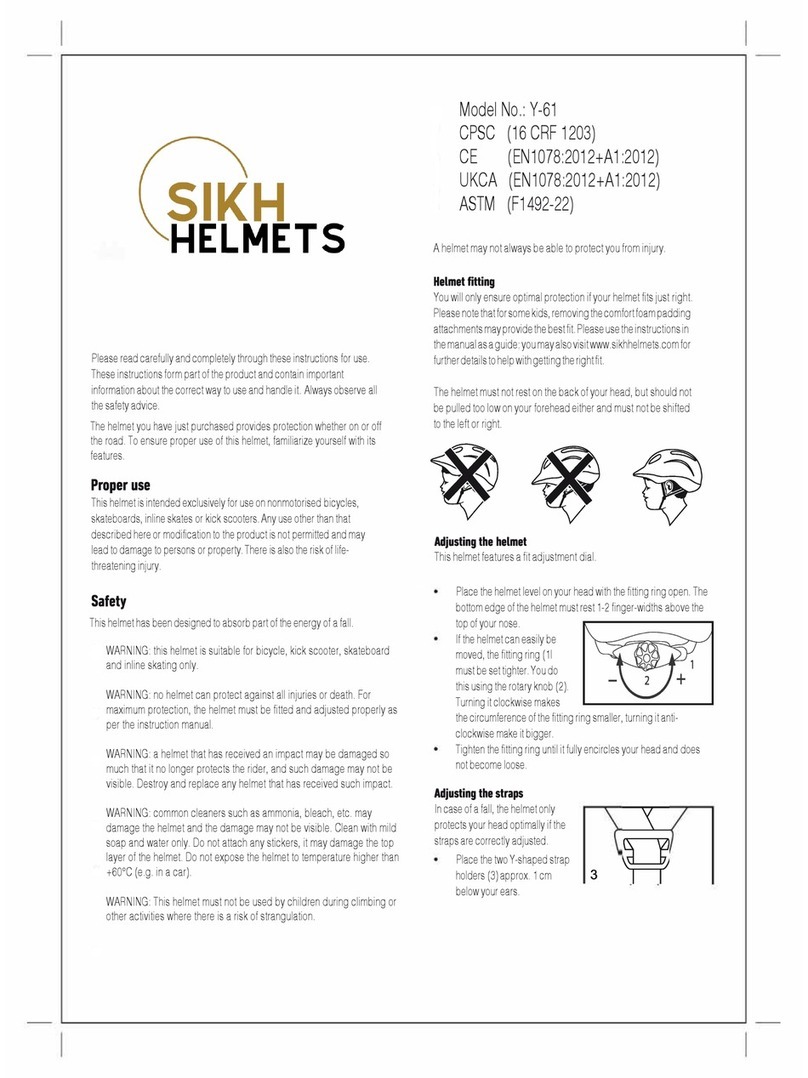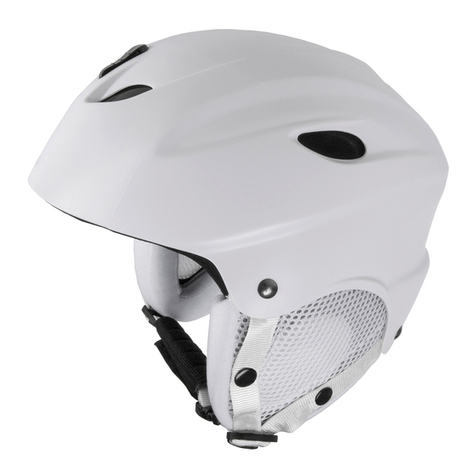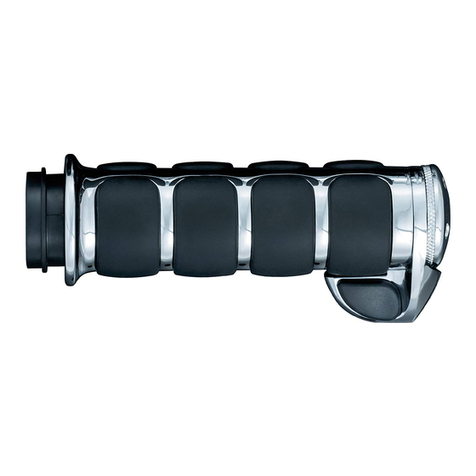LION LIBERATOR Setup guide

7200 POE AVE.
DAYTON, OHIO 45414
www.LIONprotects.com
NFPA 1951 Compliant
Technical Rescue Helmets
DANGER
!
This guide should be removed only by the end user! In the event this guide becomes
detached from the Helmet, turn this guide in to the authorities responsible for the care
and maintenance of the Helmet.
You MUST read this Guide and all Helmet Safety, Cleaning and Information labels
before wearing.
Burns are a function of time and temperature. First degree skin burns can occur when skin
reaches a temperature of as low as 118° F (47.8° C).
Fire burns at temperatures up to 2000° F (1093.3° C) or higher.
This Helmet provides limited thermal protection in compliance with NFPA 1951.
While wearing this Helmet, you may be burned without heat sensation or warning
in some circumstances, and without any sign of damage to the Helmet.
USER INSTRUCTION, SAFETY
AND TRAINING GUIDE
June 2015
IMPORTANT!
You must register the warranty
on your Helmet.
Go to
http://www.lionprotects.com/
LION-helmets-care-and-use
Earn your LION NFPA 1500
PPE Safety and Use Certificate
PPE Training is
Now Online

2
www.lionfireacademy.com
Safety and Cleaning Label
Certication Label
Content Label
Copies of labels used only on NFPA 1951 Certied Helmets
LIBERATOR™
Rescue Helmet with fiberglass
composite shell. Lexan®, ABS & high temperature
urethane foam impact cap.
U.S. PAT. NO. 4,766,609
Size: 51
/2t o 11
Lion Helmets™
Manufactured By: LION
Made in
U.S.A.
8978
FI#8978-036
Art Proof
Date: 07/12/13
Customer: Lion Apparel REV: 07-08-13
Part #: 8978
T T: 96477
PE: 039530
Artist: DWS
□
PDF / Electronic Proof
□
Match Print
(Electronic Interpretation of Color) (4 Color Process Representation)
Size: 3.375" x 1.5"
Color(s): black
Customer Approval(s):
□
Approved For Color (Match Print Only)
□
Approved For Content
□
Approved For Color & Content
Signature:________________________________ Date:___________
x
x
x
xx
DANGER
You must read and understand the instructions on this label and
contained in the User Instruction, Safety and Training Guide. Failure
to comply with these instructions may result in serious injury or death.
• Use only for Technical Rescue. NEVER contact helmet with molten metals, flames, or
hazardous chemical, biological, or radiological agents.
•Always make sure helmet is properly sized, adjusted and secured.
• Always wear helmet fully configured with all components in place.
•DO NOT USE AFTER SEVERE IMPACT; RESULTING INTERNAL DAMAGE MAY NOT
BE VISIBLE TO USER.
• Never alter the structure of this helmet, or add flammable components.
•You must have proper training in technical rescue, and knowledge of the proper selection,
fit, use, care and limitation of protective equipment.
•You must clean your helmet regularly.
Cleaning Instructions: Always clean with soap or mild detergent and warm water. Air
dry all components. Clean at least 2 times per month. Failure to clean may cause
damage to helmet and/or skin irritation.
For information, or for a User Guide, contact LION, 7200 Poe Ave., Dayton, OH 45414
Visit www.LIONprotects.com, or Call 1-800-421-2926
DO NOT MARK ON OR REMOVE THIS LABEL
8989
FI 8989-054 10672
Art Proof
Date: 07/09/13
Customer: Lion Apparel REV: 07-05-13
Part #: 8989
T T: 97263
PE: 039462
Artist: DWS
□
PDF / Electronic Proof
□
Match Print
(Electronic Interpretation of Color) (4 Color Process Representation)
Size: 4.25" x 3.0"
Color(s): black, pms185
Customer Approval(s):
□
Approved For Color (Match Print Only)
□
Approved For Content
□
Approved For Color & Content
Signature:________________________________ Date:___________
x
x
x
xx
FI8995-054 DO NOT MARK ON OR REMOVE THIS LABEL!
THIS UTILITY AND RESCUE AND RECOVERY PROTECTIVE
ENSEMBLE HELMET ELEMENT MEETS THE REQUIREMENTS OF
NFPA 1951, STANDARD ON PROTECTIVE ENSEMBLES FOR
TECHNICAL RESCUE INCIDENTS, 2013 EDITION.
PROTECTIVE UTILITY AND RESCUE AND RECOVERY HELMET FOR
TECHNICAL RESCUE OPERATIONS IN ACCORDANCE WITH 1951-2013.
3NYP
8995
Art Proof
Date: 07/12/13
Customer: Lion Apparel REV: 07-08-13
Part #: 8995
T T: 97264
PE: 041166
Artist: DWS
□
PDF / Electronic Proof
□
Match Print
(Electronic Interpretation of Color) (4 Color Process Representation)
Size: 4.75" x 2.25"
Color(s): black
Customer Approval(s):
□
Approved For Color (Match Print Only)
□
Approved For Content
□
Approved For Color & Content
Signature:________________________________ Date:___________
x
x
x
xx
Read User Guide for list of available part numbers and how properly assembled.

3
1. INTRODUCTION
Congratulations on purchasing your new LION product. Your NFPA 1951 Compliant
Technical Rescue Helmet (referred to throughout this Guide as “NFPA 1951
Compliant Helmet” or “Helmet”) is designed to provide limited protection in technical
rescue operations. It and its components are manufactured and certied under the
performance requirements of NFPA 1951: Standard on Protective Ensembles for
Technical Rescue Incidents.
The User Instruction, Safety and Training Guide gives important instructions regarding
the use, care, and maintenance of technical rescue protective helmets. No one except
you, the trained professional, should remove this guide from your helmet. Immediately
upon receipt of your helmet, you should remove, carefully read, and save this guide in a
three-ring binder for future reference.
Technical Rescue is an extremely dangerous profession. The circumstances of each
hazardous situation are unique and often impossible to predict. This guide is a
training tool to help you understand your protective helmet and how to use it in the
safest possible manner during dangerous technical rescue operations. Please take the
time to read it!
TABLE OF CONTENTS
1. Introduction ..................................................... 3
2. Denitions....................................................... 4
3. Safety Checklist .................................................. 6
4. Purpose and Limitations............................................ 7
5. Helmet Construction, Features and Function ........................... 8
6. Inspection....................................................... 9
7. Donning, Dofng, Fit and Adjustment ................................ 10
8. Marking Considerations ........................................... 12
9. Using Your Helmet Safely: How to Minimize the Risk of Injury ............. 13
10. Cleaning, Decontamination and Disinfection ........................... 16
11. Repair Methods/Installation of Replacement Parts ...................... 18
12. Storage ........................................................ 20
13. Retirement ..................................................... 21
14. Disposal ....................................................... 21
15. Limited Warranty Information ....................................... 22
16. Inspection, Cleaning, Repair, Retirement and Disposal Record............. 23

4
www.lionfireacademy.com
DANGER Indicates immediate hazards that will result in serious personal injury or death if
not avoided, or if instructions, including recommended precautions, are not followed. The
signal word “DANGER” is highlighted in red, both in this training guide and on labels afxed
to your protective Helmet, to indicate the extreme hazard of the situation.
WARNING Indicates potentially hazardous situations that could result in serious personal
injury or death if not avoided, or if instructions, including recommended precautions, are not
followed. The signal word “WARNING” is highlighted in black in this training guide.
!
WARNING
!
DANGER
For your personal safety, be alert for important safety messages in this training guide:
2. DEFINITIONS
ASTM – Acronym
for American Society of Testing
and Materials
Authority Having Jurisdiction – The
organization, ofce, or individual responsible
for approving equipment, an installation,
or a procedure.
Body Substance Isolation – A concept practiced
by emergency response personnel whereby blood
and ALL other body uids are considered a risk
for transmission of bloodborne diseases.
Biological Terrorism Agents – Liquid or
particulate agents that can consist of a
biologically derived toxin or pathogen to inict
lethal or incapacitating casualties.
Bloodborne Pathogen – Pathogenic
microorganisms that are present in human
blood and can cause disease in humans. These
include, but are not limited to: Hepatitis B,
Hepatitis C, HIV and Syphilis.
Body Fluids – Fluids produced by the body
including, but not limited to, blood, semen,
mucous, feces, urine, vaginal secretions, breast
milk, amniotic uid, cerebrospinal uid, synovial
uid, and pericardial uid.
Body Fluids-Borne Pathogen – An infectious
bacterium or virus carried in human, animal, or
clinical body uids, organs or tissue.
CBRN – An abbreviation for chemicals, biological
agents and radiological particulates hazards.
CBRN Technical Rescue Protective Ensemble
– Multiple elements of compliant protective
clothing and protective equipment designed and
congured as an ensemble to provide limited
protection in operational settings where exposure
to physical, thermal, liquid, and body uid-borne
pathogen hazards, and CBRN agents in vapor,
liquid-splash, and particulate forms are expected.
Chemical Terrorism Agents – Liquid, solid,
gaseous and vapor chemical warfare agents and
toxic industrial chemicals used to inict lethal or
incapacitating casualties, generally on a civilian
population, as a result of a terrorist attack.
Component – Any material, part or subassembly
used in the construction of the NFPA 1951
Compliant Helmet or element of the NFPA 1951
Compliant Helmet
Flame Resistance – The property of a material
whereby the application of a aming or non-aming
source of ignition and the subsequent removal
of the ignition source results in the termination of
combustion. Flame resistance can be an inherent
property of the material or it can be imparted by
specic treatment.
Flame Retardant – A chemical compound that
can be incorporated into materials or a textile ber
during manufacture or treatment to reduce its
ammability.
Flash Fire – A re that rapidly spreads through a
diffuse fuel, such as a dust, gas, or the vapors of
an ignitable liquid, without the production of
damaging pressure.
Fluorescence – The process by which radiant ux
of certain wavelengths is absorbed and reradiated,
nonthermally in other, usually longer, wavelengths.
Guide – Means this User Instruction, Safety and
Training Guide.
Helmet – (Also referred to as NFPA 1951 Compliant
Helmet.) The term Helmet used throughout this
Guide refers ONLY to NFPA 1951 Compliant
Technical Rescue Helmets.
Helmet Shell – The outermost layer of the Helmet
with the exception of trim, hardware, and eye/face
protectors. Also referred to as “shell”.
CAUTION Indicates potentially hazardous situations or unsafe practices that could result
in minor or moderate personal injury or product or property damage if instructions,
including recommended precautions, are not followed. The signal word “CAUTION” is
highlighted in gray in this Guide.
!CAUTION

5
ISP (Independent Service Provider) – An
independent third party utilized by an organization
(re department) to perform any one or any
combination of advanced inspection, advanced
cleaning, or repair services.
Interface Area – An area of the body where the
protective garments, helmets, gloves, footwear,
or SCBA facepiece meet. i.e., The protective
coat--helmet--SCBA facepiece area, the
protective coat--protective trouser area, the
protective coat--protective glove area, the
protective trouser--protective footwear area.
MSDS – Acronym for Material Safety Data Sheets.
NFPA – Acronym for National Fire Protection
Association. A private sector, volunteer-based
standard-making organization in the United States
that develops guidelines related to re protection
and prevention.
NFPA 1951 Compliant Helmet – (Also referred
to in this Guide as Helmet). Means a Helmet
certified by a private, third party certification
organization (for example, Underwriters’
Laboratories) to meet at the time of manufacture
the design and performance requirements of the
NFPA 1951 Standards.
OPIM – Acronym for Other Potentially
Infectious Materials. Includes semen, vaginal
secretions, cerebrospinal uid, synovial uid,
pleural uid, pericardial uid, amniotic uid,
and peritoneal uid.
OSHA – Acronym for Occupational Safety and
Health Administration. A government-based
standard-making body that develops public health
and safety standards for the workplace.
Protective Element – The parts or items
that comprise the protective ensemble. The
protective ensemble elements are: coats,
trousers, coveralls, helmets, gloves, footwear
and interface components.
Recovery – An operation involving the retrieval
of either (1) the remains of a deceased victim
or (2) property, but in no case a living person.
Rescue and Recovery Technical Rescue
Protective Ensemble – Multiple elements of
compliant protective clothing and protective
equipment designed and congured as an
ensemble to provide limited protection in
operational settings where exposure to physical,
thermal, liquid, and body uid-borne pathogen
hazards is expected.
Rescue and Recovery Technical Rescue
Protective Element – The coat, trouser, coverall,
or helmet element of the certied rescue and
recovery technical rescue protective ensemble
that provides protection to the upper and lower
torso, arms, legs, or head.
Responder/Emergency Responder –
Emergency personnel involved in Technical
Rescue and/or Emergency Medical Operations.
Retroreflection/Retroflective – The reection of
light in which the reected rays are preferentially
returned in the direction close to the opposite
of the direction of the incident rays, with this
property being maintained over wide variations of
the direction of the incident rays.
Retroreflective Markings – A material that reects
and returns a relatively high proportion of light in a
direction close to the direction from which it came.
SAFER – Acronym for Southern Area Fire
Equipment Research. An established body of
re equipment users with expertise in the
research and evaluation of reghting personal
protective equipment.
Stabilization – Those activities directed at
mitigating the dangerous elements of an
emergency incident.
Technical Rescue Incidents – Complex rescue
incidents requiring specially trained personnel and
special equipment to complete the mission.
Technical Rescue Operations – Those activities
directed at locating endangered persons, removing
endangered persons from danger, treating the
injured at an emergency incident, and providing
transport to an appropriate health care facility.
Trench/Cave-In Rescue – The activity of rescue
during the collapse or cave-in of a trench. A trench
is deeper than it is wide.
Trim – Retroreective and uorescent materials
attached to the outermost surface of the protective
ensemble for visibility enhancement. Retroreective
materials enhance nighttime visibility, and
uorescent materials enhance daytime visibility.
“Trim” is also known as “visibility markings”.
Useful Life – Useful life of Helmets or Helmet
components can be as little as 3 to 5 years with
heavy wear and tear and improper maintenance
and/or storage. Useful life can be as long as 7 to
10 years if Helmets have been subject to relatively
lower levels of wear and tear and have been
consistently maintained in a regular cleaning and
maintenance program and stored properly.
In compliance with NFPA 1855, Helmets must
be retired no more than 10 years from the date
of manufacture.
Utility Technical Rescue Protective
Ensemble – Multiple elements of protective
clothing and protective equipment designed and
congured as an ensemble to provide limited
protection in operational settings where exposure
to physical and thermal hazards are expected
Utility Technical Rescue Protective Element –
The coat, trouser, coverall, or helmet of the
certied utility technical rescue protective
ensemble that provides protection to the upper
and lower torso, arms, legs or head.
UV (Light or Radiation) – Acronym for Ultraviolet
Light. A type of radiated electromagnetic energy
commonly found in the sun’s rays.
Universal Precautions – Under universal
precautions, blood and certain body uids of all
patients are considered potentially infectious for
human immunodeciency virus (HIV), hepatitis B
virus (HBV), and other bloodborne pathogens.
Vehicle/Machinery Functional Capability – The
activity of removing a victim from a vehicle or
machine at an emergency incident

6
www.lionfireacademy.com
3. SAFETY CHECKLIST
Do not use this NFPA 1951 Compliant
Helmet until you have checked “YES” to
the following:
1. Have you completed formal training
in technical rescue compliant with the
approved standard recognized by the
Authority Having Jurisdiction, and on the
proper use of reghting equipment,
including Helmets?
Yes No
2. Have you read and understood all the
instructions and warnings throughout this
Guide as well as all the safety, cleaning and
information labels on the Helmet?
Yes No
3. Will you regularly inspect the Helmet inside
and out for any cracks, damage, color change,
dirt, contaminants, or embrittlement?
Yes No
4. Have you studied the limitations of your Helmet as described throughout this Guide?
Yes No
5. Have you checked to make sure that your Helmet ts you properly? Yes No
6. Have you, your safety ofcer, or another appropriate person made plans to ensure
that your Helmet is used, inspected, maintained, stored, and retired according to
instructions in this Guide? Yes No
7. Do you understand that when your skin reaches a temperature as low as 118º F
(47.8º C) you will be burned, and, that in some situations, you may not feel a heat
sensation or pain while wearing your Helmet or receive damage to your Helmet prior
to being burned? Ye s No
8. Have you read, do you understand, and do you agree to assume the risks and
responsibilities listed in the Personal Responsibility Code? See FIG. 1 and back
cover of this Guide. Yes No
If you answered NO to any of the questions, DO NOT WEAR THIS HELMET until you have read
the appropriate sections in this guide and have been properly trained by qualied instructors.
PERSONAL RESPONSIBILITY CODE
The member companies of FEMSA that provide
emergency response equipment and services want
responders to know and understand the following:
1. Firefighting and Emergency Response are inherently
dangerous activities requiring proper training in their
hazards and the use of extreme caution at all times.
2. It is your responsibility to read and understand any
user’s instructions, including purpose and
limitations, provided with any piece of equipment you
may be called upon to use.
3. It is your responsibility to know that you have been
properly trained in Firefighting and/or Emergency
Response and in the use, precautions, and care of
any equipment you may be called upon to use.
4. It is your responsibility to be in proper physical
condition and to maintain the personal skill level
required to operate any equipment you may be called
upon to use.
5. It is your responsibility to know that your equipment
is in operable condition and has been maintained in
accordance with the manufacturer’s instructions.
6. Failure to follow these guidelines may result in death,
burns or other severe injury.
Fire and Emergency Manufacturers and Services Association, Inc.
P. O. Box 147, Lynnfield , MA 01940 www.FEMSA.org
Copyright 2006 FEMSA. All Rights Reserved
FIG. 1 Personal Responsibility Code.
Also shown on back cover of
this Guide.

7
4. PURPOSE AND LIMITATIONS
This protective Helmet is designed to provide LIMITED protection to the head against
hazards arising from TECHNICAL RESCUE OPERATIONS, EMERGENCY MEDICAL
OPERATIONS, AND VICTIM EXTRICATION, INCLUDING:
• Heat and ame
• Liquid splash of ve common reground chemicals, including AFFF Foam,
battery acid, hydraulic uid, gasoline, 65% chlorine solution (see Section 10)
• Penetration of blood and other bodily uids
• Rain and hose stream water
DO NOT use this Helmet for the following:
• Structural, Proximity and Entry Firefighting (see Definitions)
• Activities requiring direct contact with flames or molten metals
• Protection against all hazardous material; chemical, biological, radiological,
or nuclear agents; or CBRN terrorism agents (see Definitions)
• Wildland Firefighting
!DANGER
Do not use
for Structural,
Proximity
and Entry
Firefighting.
Do not use for
direct contact
with flames or
molten metal.
Do not use
for protection
against
hazardous
radiological
agents.
Do not use
for protection
against
hazardous
biological
agents.
Do not use
for protection
against
hazardous
chemical
agents.
Always use your NFPA 1951 Compliant Helmet properly and in a manner that is
consistent with NFPA 1500, Standard on Fire Department Occupational Safety and Health
Program and Title 29, Code of Federal Regulations, Part 1910.132, General Requirements
of Subpart I, Personal Protective Equipment.
!DANGER
Technical rescue personnel who are exposed to a ashover, backdraft,
or other ame and high heat environments is at EXTREME risk for
extensive burn injuries and death even while wearing the Helmet!
Technical rescue personnel can encounter many common liquids
during normal performance of their duties. This helmet and
its components do not provide protection from chemicals.
The reference to limited protection from automobile uids and
some other chemicals should not be interpreted to mean that the
Helmet is suitable or is permitted to be used for protection to the
wearer during any hazardous materials situation.
!WARNING
Controlled laboratory tests in the NFPA 1951 Standard “shall not
be deemed as establishing performance levels for all situations to
which personnel can be exposed”. You should always use extreme
caution in any technical rescue situation to avoid the risk of injuries.
See NFPA 1951.
!WARNING
Protective properties in a new NFPA 1951 Compliant Helmet will
diminish as the product is worn and ages. To reduce the risk of
injuries, you MUST follow the recommendations in this Guide for
inspection and retirement of your Helmet to ensure that the Helmet
is not used past its Useful Life.

8
www.lionfireacademy.com
Burns are a function of time and temperature. The higher the temperature of the heat source
and the longer the exposure time, the greater the severity of burns.
FIRST DEGREE BURNS
begin when skin temperature reaches approximately 118° F (47.8° C).
SECOND DEGREE BURNS
occur when skin temperature reaches approximately 131° F (55° C).
THIRD DEGREE BURNS
occur when skin temperature reaches approximately 152° F (66.7° C).
You may have
very little or no warning time
from feeling heat or pain before skin begins
to burn at 118
°
F (47.8
° C)
. You need to be constantly aware of the buildup of heat in the
surrounding environment and in your Ensemble and be ready to escape to a cool area where
you can remove a hot Ensemble quickly to help prevent or reduce the severity of burns.
!DANGER
5. HELMET CONSTRUCTION, FEATURES
AND FUNCTION
Your helmet provides limited protection to your head from impact, heat, ame,
abrasion and cuts. You should study its construction to understand its functions
and limitations. (FIG. 2, FIG. 3)
5.1 HELMET SHELL 1
The Helmet shell provides the rst line of defense against blunt and sharp objects,
heat, ame and steam from above, the sides, front and rear. Although strong, the
shell is not indestructible. Severe, repeated impacts, exposures to extremely high
temperatures, or direct exposure to ame will cause
damage to the shell. See inspection process for details.
5.2 IMPACT CAP 2
The impact cap is constructed of molded
expanded polypropylene to attenuate
(absorb) harmful energy resulting from
impacts, and to insulate the wearer from
heat and ame impacting the Helmet shell.
Although strong, the impact cap is not
indestructible. Severe, repeated impacts,
exposures to extremely high temperatures, or
direct exposure to ame will cause damage.
See inspection process for details.
5.3 SUSPENSION SYSTEM
3
The suspension system attenuates (absorbs)
the harmful energy during impacts by stretching
and slowing the acceleration effect
(i.e., like the bumper on a car).
5.4 HEADBAND
4
The headband secures the entire Helmet to the head. Ensure the security of the
Helmet by tightening the ratchet band. Severe repeated impacts, exposure to
extreme heat or direct ame will cause damage to the headband.
5.5 EAR COVERS
5
The ear covers attached to the underside of the Helmet provide very limited protection
to the neck, ears and head from heat and ame. Installation is accomplished with
hook and pile strips to allow removal for cleaning. Ensure that the ear covers overlap
the upturned and secured coat collar prior to entering a hazardous area.
2
4
3
5
6
1
FIG. 2
Key Elements of
NFPA 1971 Compliant Helmets.

9
5.6 GOGGLES
6(not shown)
The goggles help protect the eyes and portions
of the face from heat, ame, and debris. Although
strong, goggles are not indestructible. Severe,
repeated impacts, exposures to extremely high
temperatures, or direct exposure to ame
will cause damage.
5.7 CHINSTRAP
7
Always securely fasten the Helmet to your head
with the adjustable chinstrap. Although strong, the
chinstrap is not indestructible. Severe, repeated
impacts, exposures to extremely high temperatures,
or direct exposure to ame will cause damage.
5.8 TRIM
8
Retroreective and uorescent trim attached to
the Helmet shell improves your visibility in low light
and daylight conditions. All reective trim may lose
reectivity under extreme heat conditions.
9
FIG. 3
Additional Key Elements of
NFPA 1951 Compliant Helmets.
7
8
5.9 LABELS
9
Important safety and cleaning information is located on the labels inside the dome
of the Helmet. The Helmet style number, date of manufacture, and the name and
address of the manufacturer are also located on the labels.
6. INSPECTING YOUR HELMET
Your Helmet should be cleaned, inspected and repaired in a frequency and manner consistent
with your re department’s protocol, NFPA 1855, and NFPA 1951.
6.1 PREPARATION
Read all Safety, Cleaning and Information Labels (See Section 5 of this Guide
for location). If any of the labels are missing, return the Helmet to the
manufacturer immediately.
6.2 FREQUENCY
Routine Inspection:
Inspect your Helmet and components at the following times:
• Upon receipt of your new Helmet or replacement component;
• after each use or at least monthly (whichever is greater) during the useful life
of the Helmet;
• after exposure to heat, ames, chemicals, or reghting agents (including
AFFF foam and water);
• after exposure to body uids (including blood); and
• after washing, repair or decontamination.
Advanced Inspection:
Your Helmet should undergo a regular Advanced Inspection by an expert in the Fire
Department who has been trained by LION, LION TotalCare®or a veried ISP at least
annually or whenever you have a question about whether a Helmet is t for use.
Most performance properties of the Helmet and its components cannot be tested by the
user in the eld. However, careful inspections prior to use are recommended. Do not use
helmets that are not thoroughly cleaned and dried.
WARNING
!

10
www.lionfireacademy.com
6.3 INSPECTION PROCESS AND CRITERIA
1. Preparation for Inspection
A. Wear appropriate gloves during inspection.
B. Ensure the Helmet is clean. If the Helmet has been contaminated
by hazardous materials or biological agents, make sure it has been
decontaminated. This is important for your safety and for assurance that
potential problems are not masked by incidental residue.
C. Place the Helmet on a clean surface in a brightly lighted area.
D. Separate Helmet components from the Helmet.
2. Inspection of the Helmet
A. Outer Shell: Examine for dirt, cracks, charring, warping or soft spots.
Cracks, charring, warping or soft spots are signs that the outer shell
may be damaged or worn out. The outer shell may need to be replaced.
B. Trim: Check for melting, loss of retroreectivity and uorescence, and
separation from shell.
C. Impact Cap: Examine for deterioration, cracks or other damage.
D. Suspension system: Examine for torn or damaged straps or padding.
E. Goggles (if present): Examine for cracks, scratches, charring, distortions
or damage.
F. Ear Cover: Look for dirt, tears, and signs of light degradation.
G. Headband: Examine for dirt, tears, breaks in the connectors, and broken
or loose adjustment ratchet.
6.4 RECORDKEEPING
LION TotalCare®Centers offer recordkeeping services. For manual records,
record all inspection and your results on the Inspection, Cleaning, Repair,
Retirement and Disposal Record located in the back of this Guide. Maintain this
form unless your organization has provided you with a comparable recordkeeping
method for this purpose.
7. DONNING, DOFFING, FIT AND ADJUSTMENT
7.1 PREPARATION
NOTE: Helmet must interface effectively with NFPA certied products which include
coat or garment, and ear covers to provide designed limited protection.
You must rst put on all protective equipment,
including coats, pants, boots, gloves, and helmet
before entering any hazard area.
7.2. DONNING
Place the Helmet on your head, connect the
chinstrap, and engage the goggles.
7.3 FIT AND ADJUSTMENT
Your safety depends upon the proper t of your Helmet. You must check the
integrity, t, and proper assembly of the Helmet, suspension, and chinstrap before
each use. Since no two heads are exactly alike, a new Helmet will need to be
adjusted to your head’s unique size and shape.
Always use your chinstrap.
Failure to use the chinstrap
may result in loss of
Helmet during emergency
operations.
WARNING
!

11
A. Headband Circumference Adjustment:
1. Turn the ratchet knob counter clockwise until
the headband is the largest size. (FIG. 4)
2. Place the Helmet on your head and turn the
ratchet knob clockwise until the headband is snug
but not constricting. One click is approximately 1/8”.
3. Connect chinstrap and use buckle to adjust the
t to be snug, yet comfortable beneath the chin.
Additional Headband Circumference Adjustment: (FIG. 5)
If necessary, you can increase or decrease the circumference of the headband
beyond the normal range of the ratchet system by altering the point at which
the rear ratchet straps connect to the front part of the headband. The factory
connects the headband at adjustment point G. To expand or reduce the
headband size:
• Remove the Helmet from your head and turn upside down.
• Locate adjustment area identied by three lock tabs on
each side of the headband. Letters indicate the position
you are selecting to assure equal adjustments on each side.
You must adjust each side equally, to assure the ratchet
strap stayed centered on the back of the head.
• Slide the strap forward or backward to the desired “lettered”
position and snap the strap into place.
• The headband will accommodate head sizes of 5 1/2 to 11.
FIG. 4
Ratcheting Wheel
U V W
X Y Z
FIG. 5
Size
Adjustment
FIG. 6
Helmet Ear Clearance
B. Vertical Adjustment:
Check vertical placement. As a general guideline,
the front part of the headband should clear your
respiratory protection facepiece and the overall
settings should have just enough height to clear
the tops of the ears. (FIG. 6)
If necessary, you can raise or lower the position
of the headband on your head as follows:
1. With Helmet off, turn the Helmet upside down
so internal components are visible.
2. Remove the headband by releasing four retaining
tabs from the shell, using recommended LION tool
(can be purchased as LION kit #LFH1058). (FIG. 7)
3. Set headband brackets to desired position and
snap the four attachment points back into place.
(FIG. 8, 9) Note: Front and back can be adjusted
differently for more customized t.
4. Try on for t. Repeat steps 2 and 3 if additional
adjustment is necessary.
5. Reattach headband and ear covers.
FIG. 8, FIG. 9
Headband Tab
Repositioning
FIG. 7
Headband
Detachment

12
www.lionfireacademy.com
C. Center of Gravity Adjusting Suspension (FIG. 11)
The adjustment tab is just in
front of the impact cap. If you
pull the tab, the impact cap
moves forward. By doing this,
you move the center point and
center of gravity forward also.
This will make the Helmet tilt
back on your head and move
more of the weight to the rear.
D. Fit Check: To determine
whether you have a properly
tting headband, hold your
head still and rock the Helmet
on your head. A properly tting
Helmet will cause your scalp to move with the Helmet. If necessary,
expand or reduce the headband circumference according to the
instructions shown in section 7.3 (A).
E. Check Interface Areas for Overlap: Ask a partner or responsible ofcer
on the scene to make sure that your ear/neck protector overlaps the collar
on your coat to provide maximum coverage to the neck area. Always make
sure no skin is exposed in interface areas between the Helmet, body,
respiratory protection and collar.
If you have trouble or need special size considerations, contact your nearest
authorized LION Helmet™dealer or call LION at 1-800-421-2926.
7.4 DOFFING
Disengage goggles. Disconnect the chinstrap and remove the Helmet. Carefully
avoid touching any contaminated areas.
FIG. 11
Center of Gravity Adjustment
8. MARKING CONSIDERATIONS
LION recommends marking only the inside of the rear brim of the Helmet with any
permanent marker.
NEVER MARK ON THE HELMET SAFETY OR CLEANING LABELS!
Turn tab sideways to adjust Helmet
FIG. 10
Suspension Tabs
For example, if the headband is too low and is too close to your eyes, you should
adjust the tabs to position “A”. (FIG. 10) While you can also adjust the front and
rear tabs to different heights, please note that the height of the complete Helmet
on your head is determined by the suspension straps which have a xed length.

13
9. USING YOUR HELMET SAFELY: HOW TO
MINIMIZE THE RISK OF INJURY
9.1 PREPARATION
Before beginning any emergency operation make sure that you are wearing your
helmet with full protective clothing, including boots and gloves before entering
any hazardous situation. Don your Helmet according to the procedures in
Section 7 of this Guide, and have another person check for proper overlap at
the interface areas.
Always wear a clean and thoroughly dry Helmet in any technical rescue operation. A soiled,
contaminated, or wet helmet may cause serious injury to the wearer.
DANGER
!
9.2 BURN HAZARDS: TYPES OF HEAT TRANSFER
There are three types of heat transfer: conduction, convection, and radiation.
Conduction is the direct transfer of heat through contact with a hot object.
Convection is the transfer of heat through a medium; for example, air. Thermal
radiation is the transfer of heat in the form of light energy, directly from ames or
reected from hot surfaces.
FLASH FIRE
Flash re means re that rapidly spreads through a diffuse fuel, such as dust, gas,
or the vapors of an ignitable liquid, without the production of damaging pressure.
Flash res mainly produce hazardous radiant heat, as well as convective heat.
The NFPA 1951 Standard is based on the knowledge that the hazard of ash res
may be present at Technical Rescue operations. Your Helmet provides minimal
protection against heat and ame. The materials are tested to provide limited ame
and heat resistance, and are tested to provide limited protection from radiant heat.
Always use your NFPA 1951 Compliant Helmet properly and in a manner that is
consistent with NFPA 1500, Standard on Fire Department Occupational Safety and Health
Program and Title 29, Code of Federal Regulations, Part 1910.132, General Requirements
of Subpart I, Personal Protective Equipment.
Flash Fires are extremely dangerous incidents. The radiant and convective heat produced by
a ash re may be severe enough that you may be burned even while wearing this Technical
Rescue Helmet, and without sustaining damage to the Helmet. If you sense combustible
gases or debris in the area, you should escape to a safe area until the dangerous condition
has been eliminated.
DANGER
!
WARNING
!
Do not confuse the component testing requirements that are part of NFPA Standards with
the conditions in which technical rescue personnel work. For example, the requirement
that certain components must not melt, drip, or separate when exposed to convected heat
temperatures of 500° F (177° C) for 5 minutes is in no way intended to indicate that you may
face that condition in your work, or could be expected to withstand that condition EVEN
WHILE WEARING AN NFPA 1951 COMPLIANT HELMET CORRECTLY without suffering
serious injury or death.

14
www.lionfireacademy.com
9.3 BURNS
Burns are a function of time and temperature.
The higher the temperature of the heat source
and the longer the exposure time, the greater the
severity of burns.
FIRST DEGREE BURNS begin when the
temperature of skin reaches 118° F (47.8° C).
SECOND DEGREE BURNS occur when the skin
reaches approximately 131° F (55° C).
THIRD DEGREE BURNS occur when skin
temperature reaches approximately
152° F (66.7° C).
Minimal protection against conductive burns: You can be burned by conductive
heat when you contact heated surfaces or objects. Your Technical Rescue Helmet
provides only minimal protection from conductive burns. It is critical to avoid
contact with any hot surfaces while wearing the Technical Rescue Helmet.
Minimal protection against convection burns: Convected heat travels through
the air, even if there is no immediate appearance of re. However, convected heat
can elevate the temperature of your Helmet enough to cause a conductive heat
burn when it comes into contact with your skin. NFPA 1951 Certied Helmets
should not be used in situations of high temperature.
Radiant heat from hot surfaces
and flames can cause burns
This NFPA 1951 Certied Technical Rescue Helmet provides only limited protection
against heat. To prevent being burned, you must avoid wearing this Technical Rescue
Helmet in high temperature environments and avoid contact with any hot surfaces.
DANGER
!
You must only use Technical Rescue Helmets in environments where no structural re is
present. In rescue situations where re is present, responders must only wear NFPA 1971
compliant structural reghter clothing.
DANGER
!
Technical Rescue personnel who are exposed to a ashover, backdraft, or other ame and
high heat environments are at EXTREME risk for extensive burn injuries and death even
while wearing their NFPA 1951 Certied Technical Rescue Helmet!
DANGER
!

15
9.4 HEAT STRESS: A SIGNIFICANT CAUSE OF FIREFIGHTER INJURIES
Physical work in a warm or hot environment causes a rise in the temperature
inside the body. To protect the body against heat, the heart begins to beat faster
so that more blood can be moved to the skin surface. Blood vessels near the skin
dilate so that they can carry more blood. In this way, blood in the interior of the
body can be brought out near the body’s surface and cooled. Most importantly,
the body produces sweat that evaporates off the skin to provide cooling. Those
natural responses do not work very well for any or all of the following conditions:
the ambient air temperature is at least 75° F (23.9° C) or higher, the PPE elements’
insulation blocks the transfer of heat away from the body, it blocks the evaporation
of sweat, or the exertion of the muscles produces more heat than the system can
remove. When the body temperature gets elevated too high, the results can be
heat strain, heat exhaustion, or heat stroke.
WARNING
!
Overexertion in hot conditions while wearing NFPA 1971 Compliant Helmets can lead
to heat exhaustion, or heat stroke. Symptoms of heat exhaustion are a general feeling
of weakness, dizziness, rapid pulse, low blood pressure while standing or sitting, and/or a
headache. The skin may feel moist or clammy. If you feel symptoms, get to a cool place,
remove your Helmet, and drink uids. Failure to seek attention could lead to coma or death.
WARNING
!
Symptoms of heat stroke are hot, dry skin with no sweating, very high body temperatures,
weakness, dizziness, rapid breathing, nausea, unconsciousness, and sometimes mental
confusion. If you feel any of the above symptoms at any time, get to a cool area immediately,
remove your Ensemble, drink uids and seek medical attention. Failure to seek attention could
lead to coma or death. Immediate cooling is essential for survival in heat stroke cases.
9.5 HEART ATTACKS: A RESULT OF OVEREXERTION
During reghting operations, the heart beats faster because of the need to move more
blood to the working muscles. This blood carries more oxygen to the muscles so that
they can handle the increased workload. Another factor in increasing the rate of the
heart is the presence of adrenaline, the “ght or ight” hormone, in the reghter’s body
during an emergency. The adrenaline present in your system causes the heart to pump
even faster than during normal activity. All of these stress factors could place too much
strain on the heart, leading to a heart attack. The heart simply cannot handle the load
placed on it.
WARNING
!
You must be physically t to safely perform strenuous work under stressful conditions. Regular
cardiovascular exercise, abstaining from cigarette smoking, proper training, a healthy diet, and
avoidance of obesity, can help to reduce the risk of heart attack.

16
www.lionfireacademy.com
WARNING
!
Your Helmet is NOT designed to protect you against electrocution. When entering a building, you
should NEVER touch live wiring, especially if your Helmet is wet. Never allow hoses, nozzles, or
other re equipment you are operating to contact live wiring.
9.7 ADDITIONAL FACTORS AFFECTING SAFETY
The following additional factors may affect the limited protection provided by
the Helmet:
• Conditions beyond the scope of the limited purposes of this Helmet;
• Unauthorized modications, repairs or replacement of components of the Helmet
not otherwise in compliance with LION’s specications; and
• The addition of accessories that are not approved by LION as compatible with
NFPA 1951 Compliant Helmets. If you have questions about whether accessories
will degrade the performance of your Helmet below the NFPA 1951 Standards,
contact LION, LION TotalCare®Center or a veried Independent Service
Provider ISP.
9.6 ELECTROCUTION
10. CLEANING, DECONTAMINATION AND
DISINFECTION
10.1 HAZARDS
You can be exposed to many hazardous substances on the job. These substances
can contaminate your Helmet, and cause harm to you after your body contacts your
Helmet. This section tells you how to clean and decontaminate your Helmet to reduce
these hazards.
Routine Contaminants: Many common contaminants are hazardous to the wearer of a
protective helmet. These substances can become embedded on the surface of the helmet
shell and in the headband and impact assembly, and enter the body through ingestion,
absorption, inhalation, and parenteral contact. In addition, contaminants can reduce the
ame resistance of your Helmet and increase its ability to conduct electricity.
Hazardous Chemicals: If you experience accidental or incidental exposure to a
hazardous chemical, follow all precautions in this section to limit exposure and risk of
harm to yourself and others. You should hose down contaminated Helmets at the scene
to limit further exposure to hazardous chemicals, to prevent exposure to others, and to
prevent contaminants from settling into your Helmet.
Bloodborne Pathogens: Your Helmet may be exposed to body uids that may contain
bloodborne pathogens. The cleaning procedures described later in this section will
reduce your risk of infection from these hazards.
10.2 FREQUENCY
Clean Helmets at least annually or as soon as possible after contamination or exposure
to tars, fuels, oils, resins, paints, acids, or any other hazardous substances.
WARNING
!
To reduce the risk of long-term harm from hazardous substances, you MUST clean your Helmet.

17
WARNING
!
NEVER use chlorine bleach or chlorinated detergents to clean your protective Helmet.
Even small amounts of chlorine will seriously reduce the protective qualities of your Helmet and
ear/neck protector.
Do Not Bleach
WARNING
!
Do not use petroleum-based solvents or paint thinners as they may degrade the protective
properties of the Helmet components and cause burns or other serious injuries.
StationCare 1851 is
available online at
www.lionprotects.com/
totalcare.
10.3 CLEANING PRODUCTS
Routine Washings:
A. Commercially available cleaners. Use
commercially available cleaning solutions with
a pH greater than 6.0 and less than 10.5. Many
household cleaning products fall within this range.
B. Specialty Cleaners. StationCare 1851 from LION
TotalCare®is designed for NFPA 1951 Garments
and other protective elements. Always read MSDS
sheets before use.
C. Spot cleaning and pre-treating. Spot cleaners
and pre-treatments are available from industrial
cleaning product suppliers. Always check MSDS
and product’s instructions before use.
10.4 CLEANING PROCEDURE
A. Shell: Fill utility sink with warm water not exceeding a temperature of 105°F
(40.6°C). Add cleaning product. See Section 10.3 Cleaning Products. Use a brush
or sponge to wipe off contaminants, soot, or dirt. Rinse with clean water. Wipe
dry or air dry.
B. Components: Fill utility sink with warm water and cleaning product. Wash browpad,
ratchet pad, and ear covers. Air dry completely at room temperature.
C. Goggles: Fill utility sink with warm water and cleaning product. Clean goggles with
soft cloth and rinse with clean water. Dry with a soft sponge or cloth. Do not use
abrasive solvents, or alcohol-based cleansers, as they may damage protective
properties of the goggles.
WARNING
!
Do not hang this Helmet in direct or indirect sunlight, or in uorescent light. Ultraviolet light
(UV rays) will severely reduce the strength and protective qualities of the Helmet.
10.5 DECONTAMINATION AND DISINFECTION
Applicable Standard. You must read and have facilities and procedures in compliance
with NFPA 1581 Standard for Fire Department Infection Control Program.
!CAUTION
Personnel involved in the handling, sorting, bagging, and transporting, of contaminated Helmets
must wear protective gloves and appropriate protective clothing to prevent occupational
exposure during these activities. For more information, read OSHA rules at 29 CFR 1910.1030.
WARNING
!
To reduce risk of harm from hazardous substances present in products of re combustion,
hazardous chemicals, and body uids, you MUST wash, decontaminate and/or disinfect your
Helmet after each exposure to hazardous substances.

18
www.lionfireacademy.com
If you have questions concerning the use of a particular disinfectant, contact LION,
a LION TotalCare®Center, or veried ISP.
A. Hazardous Subsances Present in the Products of Fire Combustion (Soot,
Smoke, and Debris): To reduce the risks associated with exposure to the
hazardous substances found in the products of re combustion, you MUST wash,
dry and store your helmets according to the procedure in this section
B. Hazardous Chemicals:
1. Hose down contaminated Helmets at the scene to limit further exposure to
hazardous chemicals, to limit exposure to others, and to limit chemicals from
settling into the Helmet.
2. KNOWN MATERIALS: Contact the source of the materials, your local
HAZMAT Team, or the Health Department to determine whether
contaminants are hazardous materials. If the contaminant is known,
contact a LION TotalCare®Center or veried ISP to determine feasibility
of decontamination.
3. UNKNOWN MATERIALS: If the contaminant is not known, Helmets should
remain out of service until the materials are identied. Always demand
MSDS information and be prepared to share nding with the LION TotalCare®
Center or veried ISP to decontaminate the Helmets. If your Helmet cannot
be decontaminated, it must be retired and disposed of in accordance
with federal, state, and local regulations.
C. Blood and Body Fluids:
1. Disinfecting Products: You must use disinfectants that are compatible with
NFPA 1951 Compliant Helmets.
2. Disinfecting Procedure for Blood and Body Fluids
Small incidental areas: Use cleaning procedures described in Section 10.4,
and use an appropriate disinfectant available for Helmets. Always
follow the instructions of the manufacturer regarding product usage.
Wash Helmets thoroughly in accordance with procedures in this section.
Large areas: If Helmets have large areas of coverage of blood or body
uids, place and transport Helmets in bags to prevent leakage. Contact
LION TotalCare®or veried ISP to arrange for disinfection.
11. REPAIR METHODS/INSTALLATION OF
REPLACEMENT PARTS
Before any repairs are made to Helmets, they must be cleaned in accordance with cleaning
instructions. It is against OSHA guidelines to expect workers to alter or repair soiled and
possibly contaminated Helmets.
WARNING
!
With the exception of the Helmet shell, LION Helmets™are designed to allow the user to remove and
replace most components in the eld. Contact your LION Helmet™dealer to order replacement parts.
The diagram on the following page gives nomenclature and placement of Helmet parts. Specic
replacement/installation instructions are included in designated replacement parts and repair
kits. Contact your nearest LION Helmet™dealer or a LION TotalCare®Center for a list of available
replacement parts and kits.
Preparation. Remove contaminated and infected Helmet from wearer and service before
beginning. Helmets should remain out of service until decontaminated and disinfected.
Wear protective gloves and appropriate protective clothing and equipment while
decontaminating and disinfecting.

19
11.1 HELMET SHELLS
For damage to Helmet shells, other than cosmetic damage such as scratches or
abrasions that are not repairable in the eld, consult with LION TotalCare®for advice on
feasibility of Helmet repair. Also read Section 13 for Retirement Considerations.
1. Trim
2. Edge Trim
3. Impact Cap
4. Four-point Chinstrap
5 & 6. Ratchet Headband and Suspension System
7. Ear Cover
TECHNICAL RESCUE HELMET
5
4
2
3
6
7
1

20
www.lionfireacademy.com
12. STORAGE
Between runs and for longer term storage, store your Helmet out of direct sunlight, indirect
sunlight, or in uorescent light. Use fans to provide good ventilation to dry Helmets which
may have absorbed water or sweat after a run and/or to ensure
the removal of any contaminants which may not have been
removed by cleaning.
Avoid prolonged exposure of your Helmet to temperature
extremes.
Failure to dry your Helmet will result in the growth of mildew
and bacteria which could lead to skin irritation, rashes, or may
affect the protective qualities of the materials.
Always clean and dry your Helmets in accordance with the
Washing Section of this Guide and before long-term storage.
NEVER STORE YOUR PROTECTIVE HELMET IN DIRECT SUNLIGHT, INDIRECT SUNLIGHT,
OR IN FLUORESCENT LIGHT. Exposure to ultraviolet light (found in the sun’s rays and
uorescent light) will severely weaken and damage some of the materials in your Helmet,
especially the ear cover, after only A FEW DAYS. Damage from UV exposure can not be
repaired, nor will the manufacturer cover such damage in its warranty. (See Warranty
Information, Section 15.)
WARNING
!
!CAUTION
NEVER store your Helmet in living quarters with personal belongings, or within the
passenger compartment of vehicles. Prolonged exposure to reground contaminants
that may have settled into a used or dirty Helmet may increase the risk of cancer or
other diseases.
Never store your Helmets
in direct sunlight,
indirect sunlight, or in
fluorescent light.
!CAUTION
Do not store your Helmet with contaminants such as oils, solvents, acids or alkalis as these
can damage the Helmet.
Table of contents

